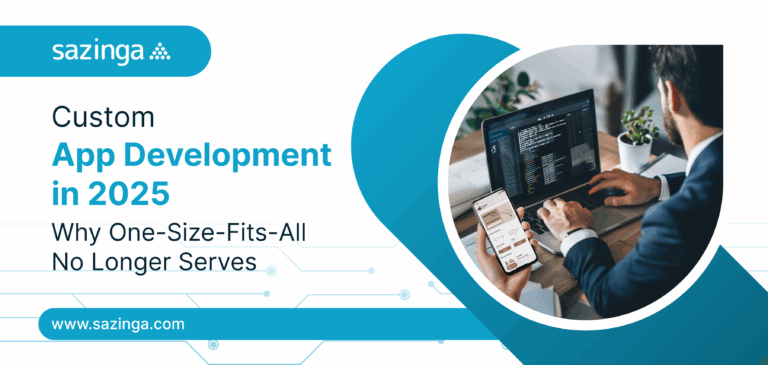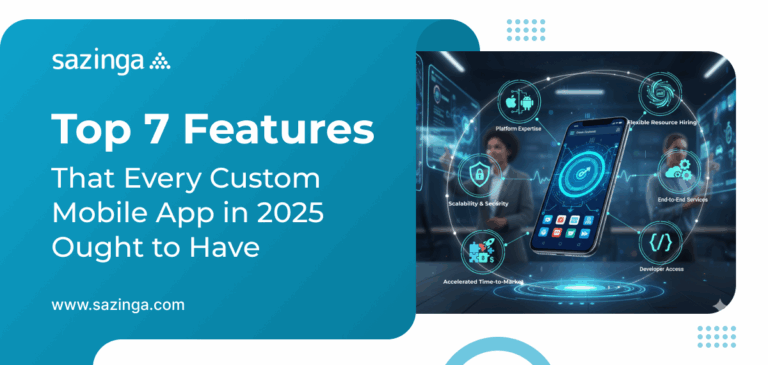How AI-Driven Mobile App Development Will Transform Industries in 2025
The fusion of artificial intelligence and mobile app development is no longer a futuristic concept. It’s today’s reality. By 2025, AI-driven mobile app development will redefine how industries operate, interact, and scale. Businesses leveraging AI-powered apps, from predictive healthcare tools to hyper-personalized shopping experiences, will dominate their markets.
This blog explores how AI is reshaping mobile app development, compares low-code and custom development approaches, and highlights real-world applications that prove why adaptability is no longer optional.
AI-Powered Mobile App Development Trends for 2025
The landscape of mobile app development is undergoing a seismic shift, driven by AI’s ability to process data, predict behavior, and automate decisions. Hyper-personalization is no longer a luxury but a necessity. Apps such as Spotify and Netflix have set the standard by analysing user preferences to curate playlists or recommend shows. By 2025, expect this trend to deepen-fitness apps will suggest workouts based on real-time stress levels, while e-learning platforms will adapt course difficulty dynamically.
Predictive analytics is another game-changer
Retail giants such as Amazon already forecast demand, but future apps will predict equipment failures in manufacturing or patient relapses in healthcare. Imagine a factory app that orders replacement parts before machines break down, saving millions in downtime.
Voice and gesture control are breaking barriers in hands-free navigation. Automotive apps like Tesla’s Autopilot use voice commands for safer driving, while healthcare apps enable surgeons to access patient data mid-procedure through simple gestures.
AI’s integration with augmented reality (AR) is equally transformative. IKEA Place’s AR feature lets users visualize furniture in their homes, but future apps will use AI to recommend products based on room dimensions, lighting, and even personal style preferences.
Low-Code Platforms vs. Full Custom Development
Choosing between low-code and custom mobile app development hinges on your business goals. Let’s examine the two approaches based on four critical factors.
Scalability
Low-code platforms excel in speed, allowing startups to launch MVPs within weeks. For instance, a café chain could quickly deploy a loyalty app to test customer engagement. However, these platforms struggle to handle high-traffic demands beyond 1 million users and often require costly workarounds.Custom development, on the other hand, builds scalability into its DNA. Fintech apps such as Revolut use custom architectures to process thousands of transactions per second without crashing. The trade-off? Development cycles stretch to 6-12 months, but the payoff is a future-proof solution.
Cost
Low-code platforms are budget-friendly, with basic apps costing under £20k. However, adding AI features like chatbots or predictive analytics can double expenses. For example, a retail app integrating an AI-driven recommendation engine might see costs spike.
Custom development demands higher upfront investment-often exceeding £50k-but offers long-term savings. For instance, a healthcare app with HIPAA compliance avoids recurring fines by embedding security protocols from day one.
Security
Low-code platforms handle GDPR updates automatically, which is ideal for small businesses lacking IT teams. Yet, their limited encryption options pose risks for industries such as finance or healthcare.
Custom development lets you implement bank-grade security. Biometric authentication, end-to-end encryption, and regular penetration testing ensure that apps meet strict standards. For example, banking apps like Monzo use custom security frameworks to protect user data.
Long-Term ROI
Low-code platforms deliver quick wins, with some MVPs achieving ROI in three months. A restaurant loyalty app might break even faster by driving repeat visits. However, limited customization often reduces user retention over time.Custom apps, while slower to mature, offer higher retention rates. Duolingo’s AI-driven language lessons, which adapt to user mistakes, have boosted engagement. Such personalization ensures users stay hooked, translating to sustained revenue.
When to Choose Which Approach
Mobile app development strategies must align with your business needs. Opt for low-code platforms if you need rapid prototyping or have a tight budget. A local retailer testing a discount app could launch in weeks without breaking the bank.
Choose custom development for complex, scalable solutions. Mental health apps requiring real-time mood analysis or fintech platforms handling sensitive transactions demand tailored architectures. For instance, a telehealth app with AI-driven diagnostics needs custom coding to ensure accuracy and compliance.
Industries Transformed by AI-Driven Mobile App Development
Healthcare
Apps such as Ada Health use AI to diagnose symptoms with 90% accuracy, reducing unnecessary clinic visits. Future apps could predict diabetic episodes by analyzing glucose levels and activity data.
Retail
Sephora’s Virtual Artist lets users “try” makeup via AR, driving a 30% sales boost. By 2025, AI will refine recommendations further, suggesting outfits based on weather, occasion, and past purchases.
Finance
Revolut’s AI detects fraudulent transactions in milliseconds, saving millions annually. Future apps could predict market trends, helping users invest more smartly.
Education
Duolingo’s AI tailors lessons to user mistakes, improving retention. Imagine apps that adapt course material based on a student’s attention span or learning speed.
In Conclusion
AI-driven mobile app development isn’t just a trend, it’s the backbone of digital transformation. By 2025, businesses without AI-powered apps will struggle to meet user expectations for speed, personalization, and security. Whether you choose low-code agility or custom development’s scalability, the key is to start now. Industries adopting AI today will lead tomorrow, turning challenges into opportunities with every line of code.







